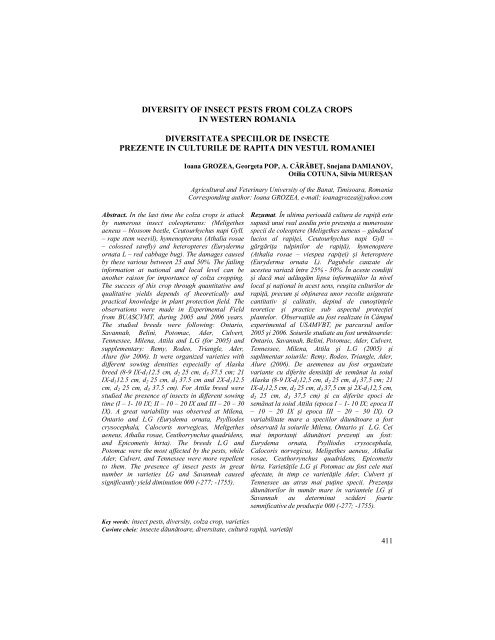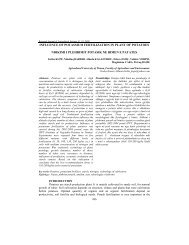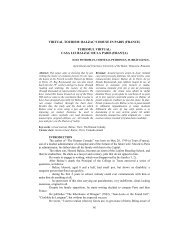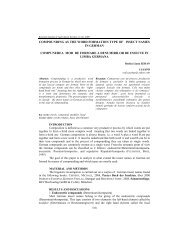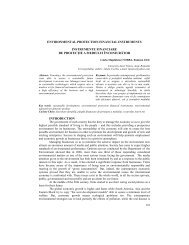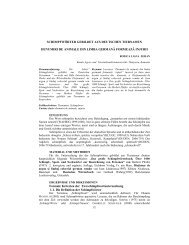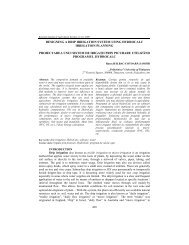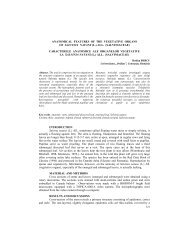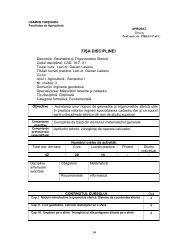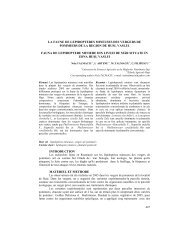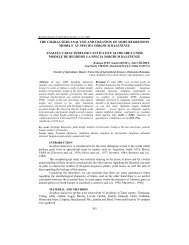diversity of insect pests from colza crops in western romania ...
diversity of insect pests from colza crops in western romania ...
diversity of insect pests from colza crops in western romania ...
You also want an ePaper? Increase the reach of your titles
YUMPU automatically turns print PDFs into web optimized ePapers that Google loves.
DIVERSITY OF INSECT PESTS FROM COLZA CROPS<br />
IN WESTERN ROMANIA<br />
DIVERSITATEA SPECIILOR DE INSECTE<br />
PREZENTE IN CULTURILE DE RAPITA DIN VESTUL ROMANIEI<br />
Abstract. In the last time the <strong>colza</strong> <strong>crops</strong> is attack<br />
by numerous <strong><strong>in</strong>sect</strong> coleopterans: (Meligethes<br />
aeneus – blossom beetle, Ceutourhychus napi Gyll.<br />
– rape stem weevil), hymenopterans (Athalia rosae<br />
– colossed sawfly) and heteropteres (Euryderma<br />
ornata L – red cabbage bug). The damages caused<br />
by these various between 25 and 50%. The fail<strong>in</strong>g<br />
<strong>in</strong>formation at national and local level can be<br />
another raison for importance <strong>of</strong> <strong>colza</strong> cropp<strong>in</strong>g.<br />
The success <strong>of</strong> this crop through quantitative and<br />
qualitative yields depends <strong>of</strong> theoretically and<br />
practical knowledge <strong>in</strong> plant protection field. The<br />
observations were made <strong>in</strong> Experimental Field<br />
<strong>from</strong> BUASCVMT, dur<strong>in</strong>g 2005 and 2006 years.<br />
The studied breeds were follow<strong>in</strong>g: Ontario,<br />
Savannah, Bel<strong>in</strong>i, Potomac, Ader, Culvert,<br />
Tennessee, Milena, Attila and L.G (for 2005) and<br />
supplementary: Remy, Rodeo, Triangle, Ader,<br />
Alure (for 2006). It were organized varieties with<br />
different sow<strong>in</strong>g densities especially <strong>of</strong> Alaska<br />
breed (8-9 IX-d112.5 cm, d2 25 cm, d3 37.5 cm; 21<br />
IX-d 112.5 cm, d 2 25 cm, d 3 37.5 cm and 2X-d 112.5<br />
cm, d2 25 cm, d3 37.5 cm). For Attila breed were<br />
studied the presence <strong>of</strong> <strong><strong>in</strong>sect</strong>s <strong>in</strong> different sow<strong>in</strong>g<br />
time (I – 1- 10 IX; II – 10 – 20 IX and III – 20 – 30<br />
IX). A great variability was observed at Milena,<br />
Ontario and L.G (Eurydema ornata, Psylliodes<br />
crysocephala, Calocoris norvegicus, Meligethes<br />
aeneus, Athalia rosae, Ceuthorrynchus quadridens,<br />
and Epicometis hirta). The breeds L.G and<br />
Potomac were the most affected by the <strong>pests</strong>, while<br />
Ader, Culvert, and Tennessee were more repellent<br />
to them. The presence <strong>of</strong> <strong><strong>in</strong>sect</strong> <strong>pests</strong> <strong>in</strong> great<br />
number <strong>in</strong> varieties LG and Savannah caused<br />
significantly yield dim<strong>in</strong>ution 000 (-277; -1755).<br />
Ioana GROZEA, Georgeta POP, A. CĂRĂBEŢ, Snejana DAMIANOV,<br />
Otilia COTUNA, Silvia MUREŞAN<br />
Agricultural and Veter<strong>in</strong>ary University <strong>of</strong> the Banat, Timisoara, Romania<br />
Correspond<strong>in</strong>g author: Ioana GROZEA, e-mail: ioanagrozea@yahoo.com<br />
Key words: <strong><strong>in</strong>sect</strong> <strong>pests</strong>, <strong>diversity</strong>, <strong>colza</strong> crop, varieties<br />
Cuv<strong>in</strong>te cheie: <strong><strong>in</strong>sect</strong>e dăunătoare, diversitate, cultură rapiţă, varietăţi<br />
Rezumat. În ultima perioadă cultura de rapiţă este<br />
supusă unui real asediu pr<strong>in</strong> prezenţa a numeroase<br />
specii de coleoptere (Meligethes aeneus – gândacul<br />
lucios al rapiţei, Ceutourhychus napi Gyll –<br />
gărgăriţa tulp<strong>in</strong>ilor de rapiţă), hymenoptere<br />
(Athalia rosae – viespea rapiţei) şi heteroptere<br />
(Euryderma ornata L). Pagubele cauzate de<br />
acestea variază între 25% - 50%. În aceste condiţii<br />
şi dacă mai adăugăm lipsa <strong>in</strong>formaţiilor la nivel<br />
local şi naţional în acest sens, reuşita culturilor de<br />
rapiţă, precum şi obţ<strong>in</strong>erea unor recolte asigurate<br />
cantitativ şi calitativ, dep<strong>in</strong>d de cunoşt<strong>in</strong>ţele<br />
teoretice şi practice sub aspectul protecţiei<br />
plantelor. Observaţiile au fost realizate în Câmpul<br />
experimental al USAMVBT, pe parcursul anilor<br />
2005 şi 2006. Soiurile studiate au fost următoarele:<br />
Ontario, Savannah, Bel<strong>in</strong>i, Potomac, Ader, Culvert,<br />
Tennessee, Milena, Attila şi L.G (2005) şi<br />
suplimentar soiurile: Remy, Rodeo, Triangle, Ader,<br />
Alure (2006). De asemenea au fost organizate<br />
variante cu diferite densităţi de semănat la soiul<br />
Alaska (8-9 IX-d 112,5 cm, d 2 25 cm, d 3 37,5 cm; 21<br />
IX-d112,5 cm, d2 25 cm, d3 37,5 cm şi 2X-d112,5 cm,<br />
d 2 25 cm, d 3 37,5 cm) şi cu diferite epoci de<br />
semănat la soiul Attila (epoca I – 1- 10 IX; epoca II<br />
– 10 – 20 IX şi epoca III – 20 – 30 IX). O<br />
variabilitate mare a speciilor dăunătoare a fost<br />
observată la soiurile Milena, Ontario şi L.G. Cei<br />
mai importanţi dăunători prezenţi au fost:<br />
Eurydema ornata, Psylliodes crysocephala,<br />
Calocoris norvegicus, Meligethes aeneus, Athalia<br />
rosae, Ceuthorrynchus quadridens, Epicometis<br />
hirta. Varietăţile L.G şi Potomac au fost cele mai<br />
afectate, în timp ce varietăţile Ader, Culvert şi<br />
Tennessee au atras mai puţ<strong>in</strong>e specii. Prezenţa<br />
dăunătorilor în număr mare în variantele LG şi<br />
Savannah au determ<strong>in</strong>at scăderi foarte<br />
semnificative de producţie 000 (-277; -1755).<br />
411
INTRODUCTION<br />
Much utilization was allocated to this plant over time, but the ma<strong>in</strong> one is the<br />
importance <strong>in</strong> <strong>in</strong>dustry like oils car, lubricants, and pa<strong>in</strong>ts). Colza is a good honey -bear<strong>in</strong>g<br />
plant and an excellent green fodder, too. The <strong>pests</strong> witch frequented the <strong>colza</strong> fields, <strong>from</strong> our<br />
country are numerous and majors because the damages and the loss caused to seed and green<br />
material.<br />
MATERIAL AND METHODS<br />
For comparative studies were used some <strong>colza</strong> varieties Ontario, Savannah, Bel<strong>in</strong>i,<br />
Potomac, Ader, Culvert, Tennessee, Milena, Attila şi L.G (for 2005) and supplementary: Remy,<br />
Rodeo, Triangle, Ader, Alure (for 2006). It was organized varieties with different sow<strong>in</strong>g<br />
densities especially <strong>of</strong> Alaska breed (8-9 IX-d112.5 cm, d2 25 cm, d3 37.5 cm; 21 IX-d112.5 cm,<br />
d2 25 cm, d3 37.5 cm and 2X-d112.5 cm, d2 25 cm, d3 37.5 cm). For Attila breed were studied<br />
the presence <strong>of</strong> <strong><strong>in</strong>sect</strong>s <strong>in</strong> different sow<strong>in</strong>g time (I – 1- 10 IX; II – 10 – 20 IX and III – 20 – 30<br />
IX).<br />
The harvest <strong>of</strong> trials was carried out <strong>in</strong> May 24, May 30 and June 15 (for 2005), this<br />
period correspond the flower<strong>in</strong>g and silicve form<strong>in</strong>g. The experience was organized to 100 m 2<br />
length<strong>in</strong>ess and width 90 m 2 . There are a net partition among different varieties and densities<br />
(only to Alaska variety). The observations were made <strong>in</strong> Experimental Field <strong>from</strong><br />
BUASCVMT, dur<strong>in</strong>g 2005 and 2006 years.<br />
RESULTS AND DISCUSSION<br />
The results were similar for 2005 year and 2006, too.<br />
Through comparison <strong>of</strong> entomophauna present to different varieties <strong>of</strong> <strong>colza</strong> (graphic<br />
1, table 2), a great variability was observed at Milena, Ontario and L.G.<br />
Thus, the follow pest Eurydema ornata-red bug <strong>of</strong> cabbage, Psylliodes crysocephalablue<br />
flea <strong>of</strong> <strong>colza</strong>, Calocoris norvegicus-green bug <strong>of</strong> <strong>colza</strong>, Meligethes aeneus-sh<strong>in</strong>y beetle <strong>of</strong><br />
<strong>colza</strong>, Athalia rosae-<strong>colza</strong> hornet, Ceuthorrynchus quadridens-weevil <strong>of</strong> <strong>colza</strong> stem,<br />
Epicometis hirta-shaggy beetle, were observed. The breeds L.G and Potomac were the most<br />
affected by the <strong>pests</strong>, while Ader, Culvert, and Tennessee were more repellent to them (table<br />
1).<br />
For 2006, the most attacked varieties by <strong>pests</strong> were follow<strong>in</strong>g: Savannah, Milena,<br />
Ontario, Attila, and L.G (table 3).<br />
Nearly these there were present other <strong>pests</strong>, too. These were unspecific ally to <strong>colza</strong><br />
cultures, without economically importance. The breeds L.G and Potomac were the most<br />
affected by the <strong>pests</strong>, while Ader, Culvert, and Tennessee were more repellent to them.<br />
In flower<strong>in</strong>g period were predom<strong>in</strong>ates the species <strong>from</strong> Phyllotreta. In silicval<br />
form<strong>in</strong>g period were prevalent the follow species: Eurydema ornata, Psylliodes crysocephala<br />
and Ceuthorrynchus quadridens.<br />
Regard<strong>in</strong>g to behaviour <strong>of</strong> the Alaska breed at different densities, depend<strong>in</strong>g on the<br />
<strong>pests</strong> attack, it can be concluded that the sow<strong>in</strong>g at a higher density (12.5 cm) attracted more<br />
important <strong>pests</strong> than that at a lower one (25.0 cm, 37.5 cm) (graphic 2).<br />
Sow<strong>in</strong>g time <strong>in</strong>fluenced the presence <strong>of</strong> <strong>pests</strong> <strong>in</strong> <strong>colza</strong> culture (especially to Alaska<br />
variety). On the plots, where <strong>colza</strong> was cultivated earlier (September 8-9, September 21), the<br />
pest species were more numerous and had a greater variability than those present at the <strong>colza</strong><br />
cultivated later on (October 2). The similar situation was registered for 2006 (table 4).<br />
412
Diversity <strong>of</strong> pest species <strong>from</strong> <strong>colza</strong> crop <strong>in</strong> 2005<br />
ORDER FAMILY SPECIES<br />
Eurydema ornata<br />
Pentatomidae<br />
Eurydema oleraceum<br />
Heteroptera<br />
Calocoris norvegicus<br />
Miridae Lygus pratensis<br />
Scutelleridae Eurygaster austriaca.<br />
Miridae Lyxus junci<br />
Chrysomelidae<br />
Phyllotreta atra<br />
Psylliodes crysocephala<br />
Nitidulidae Meligethes aeneus<br />
Coleoptera<br />
Scarabeidae<br />
Curculionidae<br />
Epicometis hirta<br />
Ceuthorrynchus quadridens<br />
Cantharidae Cantharis fusca<br />
Chrysomelidae Phytodecta fornicata<br />
Cocc<strong>in</strong>elidae Cocc<strong>in</strong>ela sp.<br />
Hymenoptera<br />
Tenthredimidae Athalia rosae<br />
Cephidae Cephus pygmaeus<br />
Lepidoptera Noctuidae Mamestra brassicae<br />
Diptera Anthomyiidae Delia floralis<br />
Variety<br />
The ma<strong>in</strong> <strong>pests</strong> <strong>in</strong> some <strong>colza</strong> varieties, <strong>in</strong> 2005<br />
Euryderma<br />
ornata<br />
Meligethes<br />
aeneus<br />
Psylliodes<br />
crysocephal<br />
a<br />
Species<br />
Athalia<br />
rosae<br />
Ceuthorync<br />
hus<br />
quadridens<br />
Table 1<br />
Table 2<br />
Calocoris<br />
norvegicus<br />
Milena 55 5 31 3 18 16<br />
Savannah 26 3 23 1 19 5<br />
Potomac 22 3 51 6 8 8<br />
Bel<strong>in</strong>i 4 0 55 4 4 9<br />
Ontario 62 5 6 8 13 19<br />
L.G. 97 2 16 4 4 14<br />
Ader 19 2 0 3 0 1<br />
Culvert 10 0 15 1 4 0<br />
Tennessee 21 0 10 0 0 12<br />
Attila 43 5 32 4 0 12<br />
413
414<br />
100<br />
90<br />
80<br />
70<br />
60<br />
50<br />
40<br />
30<br />
20<br />
10<br />
0<br />
No <strong>of</strong> <strong>pests</strong><br />
Milena<br />
Potomac<br />
Ontario<br />
Ader<br />
Tennessee<br />
Euryderma ornata Meligethes aeneus<br />
Psylliodes crysocephala Athalia rosae<br />
Ceuthorynchus quadridens Calocoris norvegicus<br />
Figure 1 The presence <strong>of</strong> ma<strong>in</strong> <strong>pests</strong> <strong>in</strong> different varieties <strong>of</strong> <strong>colza</strong><br />
No. <strong>of</strong><br />
180<br />
160<br />
140<br />
120<br />
100<br />
80<br />
60<br />
40<br />
20<br />
0<br />
Euryderma<br />
ornata<br />
Psylliodes<br />
crysocephala<br />
Ceuthorynchus<br />
quadridens<br />
Species<br />
12,5 cm 25,0 cm 37,5 cm<br />
Figure 2 Influence <strong>of</strong> sow<strong>in</strong>g density to Alaska variety on presence <strong>of</strong> ma<strong>in</strong> <strong>pests</strong><br />
Varieties<br />
The presence <strong>in</strong> great number <strong>of</strong> <strong>pests</strong> <strong>in</strong> LG and Savannah varieties caused<br />
significantly dim<strong>in</strong>utions <strong>of</strong> yield 000 (-277; -1755) (table 5).
Variety<br />
Euryderma<br />
ornata<br />
The ma<strong>in</strong> <strong>pests</strong> <strong>in</strong> some <strong>colza</strong> varieties, <strong>in</strong> 2006<br />
Meligethes<br />
aeneus<br />
Species<br />
Psylliodes<br />
crysocephala Athalia rosae<br />
Ceuthorynch<br />
us<br />
quadridens<br />
Table 3<br />
Calocoris<br />
norvegicus<br />
Savannah 10 2 14 1 11 2<br />
Coulvert 6 1 0 1 2 0<br />
Bel<strong>in</strong>i 3 1 21 0 2 4<br />
Milena 38 3 17 1 11 9<br />
Potomac 10 2 31 2 5 6<br />
Attila 23 3 20 1 0 2<br />
Remy 0 4 2 1 2 0<br />
Rodeo 3 2 0 1 0 1<br />
Triangle 6 0 1 2 1 11<br />
LG 63 0 10 0 2 9<br />
LG 26 13 22 3 14 11<br />
Ader 10 0 1 1 0 1<br />
Alure 3 1 2 1 2 3<br />
Tennesse 11 0 5 0 1 9<br />
Ontario 41 3 2 6 9 11<br />
Sow<strong>in</strong>g<br />
density<br />
1 – 10 IX<br />
10 – 20 IX<br />
20 – 30 IX<br />
Presence <strong>of</strong> ma<strong>in</strong> <strong>pests</strong> <strong>in</strong> different sow<strong>in</strong>g density to Alaska variety<br />
Euryderma<br />
ornata<br />
Meligethes<br />
aeneus<br />
Psylliodes<br />
crysocephala<br />
Athalia<br />
rosae<br />
Species<br />
Ceuthorynchus<br />
quadridens<br />
Table 4<br />
Calocoris<br />
norvegicus Epicometis hirta<br />
106 2 10 12 9 7 3<br />
34 4 16 2 7 8 8<br />
23 4 6 10 5 5 1<br />
The yield significance <strong>in</strong> some <strong>colza</strong> varieties, <strong>in</strong> 2005 year<br />
No Variety Yield (Kg/ha) %<br />
1 ATTILA 4808<br />
Difference<br />
(Kg/ha)<br />
Significance<br />
2 ADER 5332 110 524 X<br />
3 MILENA 5837 121 1029 XXX<br />
4 ONTARIO 5486 114 678 X<br />
5 BELINI 6166 128 1358 XXX<br />
6 SAVANNAH 3053 63 -1755 000<br />
7 TENNESSE 4517 93 -291<br />
8 LG 4531 94 -277<br />
9 COULVERT 5958 123 1150 XXX<br />
Table 5<br />
415
416<br />
CONCLUSIONS<br />
A great variability <strong>of</strong> <strong>pests</strong> was observed at Milena, Ontario and L.G<br />
The major <strong>pests</strong> <strong>in</strong> <strong>colza</strong> cultures were the follow<strong>in</strong>g: Eurydema ornata, Psylliodes<br />
crysocephala, Calocoris norvegicus, Meligethes aeneus, Athalia rosae, Ceuthorrynchus<br />
quadridens, and Epicometis hirta.<br />
The breeds L.G and Potomac were the most affected by the <strong>pests</strong>, while Ader, Culvert<br />
and Tennessee were more repellent to them.<br />
The sow<strong>in</strong>g at a higher density (12.5 cm) attracted more important <strong>pests</strong> than that at a<br />
lower one (25 cm, 37.5 cm).<br />
On the plots, where <strong>colza</strong> was cultivated earlier, the pest species were more numerous<br />
and had a greater variability than those present at the <strong>colza</strong> cultivated later.<br />
The presence <strong>in</strong> great number <strong>in</strong> LG and Savannah varieties caused significantly<br />
dim<strong>in</strong>utions <strong>of</strong> yield 000 (-277; -1755).<br />
LITERATURE<br />
GHIZDAVU I., PAŞOL P., PĂLĂGEŞIU I., BOBÂRNAC B., FILIPESCU C., MATEI I., GEORGESCU T., BAICU T.,<br />
BĂRBULESCU A., Entomologie agricolă. Ed. Did. şi Ped. Bucureşti. 1997<br />
GROZEA IOANA, 2006, Entomologie specială, Ed. Mirton, Timişoara, 332p p.<br />
LEONARDI C., 1993 - Insekten, verleght bei, Kaiser Klagenfurt.<br />
LINSSEN E.F.,1996- Insects. Pengu<strong>in</strong> books, Revised Edition.<br />
PĂLĂGEŞIU I., SÂNEA NICOLAE, PETANEC DORU, GROZEA IOANA, 2000, Ghid practic de entomologie<br />
agricolă şi horticolă, Edit. Mirton, Timişoara.<br />
PERJU T., 2004, Dăunătorii d<strong>in</strong> pr<strong>in</strong>cipalele agroecosisteme şi combaterea lor <strong>in</strong>tegrată, Ed. Academic<br />
Pres, Cluj Napoca.<br />
PERJU T. 1999, Dăunătorii organelor de fructificare şi măsurile de combatere <strong>in</strong>tegrată (vol.I) Plante<br />
ierboase. Ed. Ceres Bucureşti.


